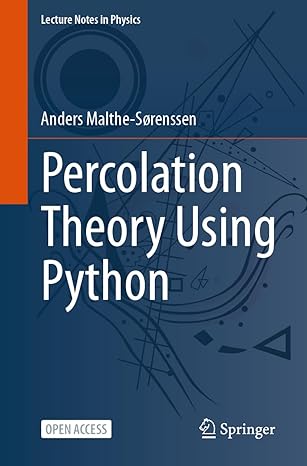
Percolation Theory Using Python (Lecture Notes in Physics, 1029)
Author: Anders Malthe-Sørenssen (Author)
Publisher finelybook 出版社: Springer
Edition 版次: 2024th
Publication Date 出版日期: 2024-06-30
Language 语言: English
Print Length 页数: 224 pages
ISBN-10: 3031598997
ISBN-13: 9783031598999
Book Description
This course-based open access textbook delves into percolation theory, examining the physical properties of random media―materials characterized by varying sizes of holes and pores. The focus is on both the mathematical foundations and the computational and statistical methods used in this field. Designed as a practical introduction, the book places particular emphasis on providing a comprehensive set of computational tools necessary for studying percolation theory.
Readers will learn how to generate, analyze, and comprehend data and models, with detailed theoretical discussions complemented by accessible computer codes. The book’s structure ensures a complete exploration of worked examples, encompassing theory, modeling, implementation, analysis, and the resulting connections between theory and analysis.
Beginning with a simplified model system―a model porous medium―whose mathematical theory is well-established, the book subsequently applies the same framework to realistic random systems. Key topics covered include one- and infinite-dimensional percolation, clusters, scaling theory, diffusion in disordered media, and dynamic processes. Aimed at graduate students and researchers, this textbook serves as a foundational resource for understanding essential concepts in modern statistical physics, such as disorder, scaling, and fractal geometry.
From the Back Cover
This course-based open access textbook delves into percolation theory, examining the physical properties of random media―materials characterized by varying sizes of holes and pores. The focus is on both the mathematical foundations and the computational and statistical methods used in this field. Designed as a practical introduction, the book places particular emphasis on providing a comprehensive set of computational tools necessary for studying percolation theory.
Readers will learn how to generate, analyze, and comprehend data and models, with detailed theoretical discussions complemented by accessible computer codes. The book’s structure ensures a complete exploration of worked examples, encompassing theory, modeling, implementation, analysis, and the resulting connections between theory and analysis.
Beginning with a simplified model system―a model porous medium―whose mathematical theory is well-established, the book subsequently applies the same framework to realistic random systems. Key topics covered include one- and infinite-dimensional percolation, clusters, scaling theory, diffusion in disordered media, and dynamic processes. Aimed at graduate students and researchers, this textbook serves as a foundational resource for understanding essential concepts in modern statistical physics, such as disorder, scaling, and fractal geometry.
About the Author
Anders Malthe-Sørenssen is the director of the Center for Computing in Science Education, a Center for Excellence in Education, and a Professor of Physics at the University of Oslo. His research interests span the nanoscale and statistical physics, friction, physics of geological processes, neuroscience and AI. Currently, his teaching efforts are focused on revitalizing undergraduate science courses by seamlessly integrating computational methods, providing students with early exposure to research and industrially relevant problems.








